Inbox and Environment News Issue 196
January 4 - 10, 2015: Issue 196
Brothers From the Bush
Published on 31 Dec 2014
Rick Kelly and his brother Todd balance the importance of family and a life of professional racing in Australia's premiere racing category. Shot 100% on the HERO3+® camera fromhttp://GoPro.com. Get stoked and subscribe: http://goo.gl/HgVXpQ
Music
Blue Sky Black Death"Fortune": Link to buy: http://goo.gl/bFUzXN;Insightful "Not Afraid To Be Alone": Link to buy: http://goo.gl/vbR1nv;Lorn "Cherry Moon": Link to buy: http://goo.gl/5SGBWo
Additional Music Courtesy of ExtremeMusic: http://extrememusic.com
Make a New Year's resolution to manage your diabetes
December 31, 2014 - José Rodriguez often skipped breakfast and lunch only to eat a large dinner at the end of the day. Despite his erratic eating habits, Mr. Rodriguez thought he was healthy until a routine blood test revealed he had type 2 diabetes.
"I was shocked. I didn't expect to be a diabetic," Mr. Rodriguez said. "I told my doctor that I would do whatever it takes to manage my disease."
Mr. Rodriguez was referred to the diabetes education program at Loyola University Medical Center. A certified diabetes educator worked with him to make diet and lifestyle changes. This included cutting out soda, monitoring the food he eats, altering his portions, exercising more and checking his blood sugar.
"I didn't like vegetables. That was a challenge for me," Mr. Rodriguez said. "But once I learned more about eating well and portions, it helped me get my diabetes under control. I now eat well-balanced meals and exercise four to five times a week for an hour at a time."
Approximately 3.61 million Australians have diabetes or pre-diabetes, and 366 million people have diabetes worldwide. (1).
Symptoms of diabetes include:
• Urinating often
• Feeling very thirsty
• Feeling very hungry - even though you are eating
• Extreme fatigue
• Blurry vision
• Cuts/bruises that are slow to heal
• Tingling, pain or numbness in the hands/feet (type 2)
Early detection and treatment can decrease the risk of developing complications from diabetes. Loyola's certified diabetes educators report that the new year is a good time to see a doctor if you think you have diabetes.
"The new year is an excellent time to take charge of your health and make any necessary adjustments to diet and lifestyle, so you control your diabetes rather than letting the disease control you," said Heidi King, RD, CDE, the certified diabetes educator who counseled Mr. Rodriguez.
(1) Diabetes Atlas. IDF, 2011
The above story is based on materials provided by Loyola University Health System.
Resolved to lose weight in 2015? Here are five bad strategies to avoid
Is your New Year's resolution to lose weight? Here are five bad strategies to avoid, according to Dr. Aaron Michelfelder of Loyola University Health System:
Bad strategy No. 1: I'll lose weight at the gym.Working out is good for your health and can help to maintain your weight. But exercise alone is not very effective in shedding pounds. To lose weight, you will need to eat fewer calories.
Bad Strategy No. 2: I'll have to dramatically change my diet. A radical change is not necessary. A more effective strategy is to simply cut back a few hundred calories a day. When going to a restaurant, for example, eat an apple before dinner to dull your appetite, then skip the bread before the main dish arrives. Eat smaller portions and ask for a to-go container.
Bad Strategy No. 3: Weight-loss supplements will make it easier. Supplements burn more muscle than fat. And when you stop taking them, you will gain back more fat than muscle, making you worse off than if you had never taken them in the first place.
Bad Strategy No. 4: I want to be like the Biggest Loser and shed pounds quickly. A more realistic - and healthy - strategy is to try to lose 1 to 2 pounds per week. If you cut back 500 calories a day (such as a bagel and cream cheese), you will lose a pound a week. If you cut back just 250 calories a day (one candy bar) you will lose 2 pounds a month. "This will provide the slow-and-steady type of weight loss that will be long-lasting," Dr. Michelfelder said.
Bad Strategy No. 5: I give up. I'll never get down to a normal weight, so why even try? Do not despair if you do not get down to a trim, normal weight (defined as a body mass index of between 18.5 and 24.9). If you are overweight or obese, losing 10 percent of your body weight will improve your appearance and have significant health benefits, such as lower blood pressure and a reduced risk of diabetes. Even losing as little as 5 pounds will be good for your joints.
As a family physician, Dr. Michelfelder fields a lot of questions every January from patients who have resolved to lose weight. He advises them to not try to go it alone. "When you tell other people you are trying to lose weight, they will give you their support, and stop shoving cake and candy your way," Dr. Michelfelder said.
Structured programs, such as Weight Watchers and Jenny Craig, can be effective. And attending such programs in person tends to be more effective than participating only online, Dr. Michelfelder said.
"For the New Year, most of us should add some weight loss to our resolutions," Dr. Michelfelder said. "Obesity is now so common in the United States that it causes more disease and years of life lost than smoking."
Dr. Michelfelder is a professor in the Department of Family Medicine of Loyola University Chicago Stritch School of Medicine.
The above story is based on materials provided by Loyola University Health System
Looking forward to the 24th century: Cardiac arrest remains a deadly problem - but for different reasons from today
December 29, 2014 - The Star Trek universe is one of the most popular pieces of science fiction entertainment. Lots of the technologies seen in the TV and cinema episodes featuring Captain Kirk, Mr Spock or Captain Picard were once regarded as futuristic, but have now become reality - with examples including wireless communication or portable computers. In a recent study by the University Department of Emergency Medicine at the MedUni Vienna, the make-believe future of the human race depicted in this series has been used to investigate the frequency and mortality of cardiac arrests in the 24th century.
Right from the start, the scientists were involved in the production of the Star Trek series. The famous researcher Stephen Hawking, a self-confessed Star Trek fan, once wrote in a preface that the series "expands the human imagination." Many of the technical devices that occur very early on in the series have become reality. Even in the pilot film in 1966, the crew was given a message on a sheet of paper that was emitted from a machine. In those days, the fax machine hadn't even been invented. It wasn't until 1979 that the first fax machines were connected to the telephone network.
Captain Kirk's "communicator" from 1966 can be regarded as the fore-runner to the modern-day mobile phone. Some manufacturers later declared that they had been inspired by Star Trek. The same goes for hands-free earpieces, flat screens, video phones or a type of laptop. All of these had been used in the Star Trek series long before they were used in the real world.
Emergency medicine in the make-believe 24th century
Scientists at the MedUni Vienna now used this vision of the future to take a look at emergency medicine in the make-believe 24th century. The result: even in the world of Star Trek, a cardiac arrest is associated with high mortality - albeit less due to general medical reasons than today. "The treatment of cardiac arrests is a very highly-researched field of modern medicine. Unfortunately, survival rates after an event such as this have continued to stagnate at a low level for many years," explains study leader David Hörburger. "The aim of the study was to analyse its epidemiology and treatment in the way it is fictitiously portrayed in the 24th century in the world of Star Trek in order to find inspiration for the present day."
526 episodes of the TV series "Star Trek - The Next Generation," "Star Trek: Deep Space Nine" and "Star Trek: Voyager" were studied to determine the occurrence of cardiac arrests. A total of 96 cardiac arrests were documented and analysed.
In the 24th century, people "live" more healthily
A cardiac arrest is therefore associated with high mortality in the 24th century too (around 90 per cent). However, an analysis of how they are portrayed in the Star Trek series illustrates a significant shift in the cause from general medical to traumatological, i.e. death caused by severe physical injury, injury caused by "energy weapons" and poisoning, rather than by heart attacks or cardiac arrhythmias, which are the most common causes of present-day cardiac arrests. Says Hörburger: "This invites the conclusion that people in the future will be living much more healthily and will have better preventative medicine than we do now."
Another interesting result of this analytical glimpse of a make-believe future is that, today, people who suffer a cardiac arrest in hospital have the best chances of survival, followed by patients who have a cardiac arrest in the street. The poorest outlook is reserved for people who have a cardiac arrest at home. In the Star Trek future presented in this study, this situation is different - and can be explained by the technology of "teleportation," i.e. the lightning-fast transport of a human through the transfer of matter from one location to another. Hand-held medical scanners ("tricorders") were also used frequently in the programmes and helped to treat patients.
1. David Hörburger, Julia Haslinger, Hubert Bickel, Nikolaus Graf, Andreas Schober, Christoph Testori, Christoph Weiser, Fritz Sterz, Moritz Haugk. Where no guideline has gone before: Retrospective analysis of resuscitation in the 24th century.Resuscitation, 2014; 85 (12): 1790 DOI:10.1016/j.resuscitation.2014.10.008
Piano Tree
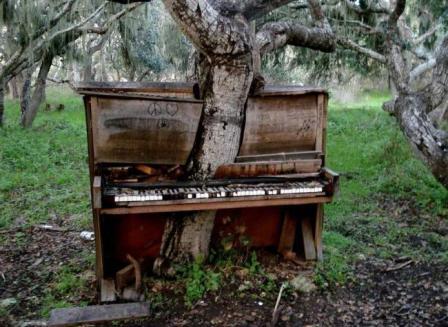
Rolex Sydney Hobart: A Wild Wild win or two
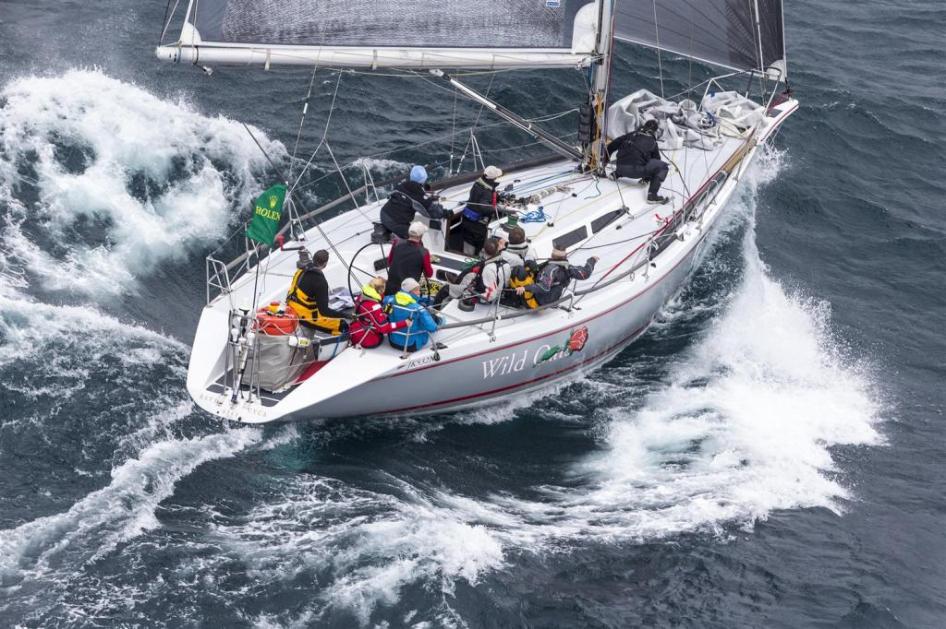
Rolex Sydney Hobart: A Wild Wild win or two
30 Dec 2014
Who could have known at any stage of the Rolex Sydney Hobart Yacht Race that boats touched by Bob Oatley and both bearing the name ‘Wild’ in their title would take line honours and overall corrected time honours in the 70th edition of the race and the 70th anniversary of the Cruising Yacht Club of Australia?
That is exactly what happened today. Wild Rose, Bob Oatley’s first grand prix ocean racer, sailed into Hobart yesterday, her owner Roger Hickman having to wait until today to be declared overall winner of the race with the 29-year-old yacht.
On Sunday, Bob Oatley’s 100-foot supermaxi Wild Oats XI logged a record eighth line honours victory after an epic battle with brand new super maxi Comanche, cementing Oatley’s place in ocean racing history.
What it says is that two yachts with the Oatley name attached have won line and overall honours in the 2014 Rolex Sydney Hobart.
This is not the first time Hickman has won the race with the yacht that he affectionately refers to as “the old girl”. With his partners Bruce Foye and Lance Peckman, Hickman won the race under the old IOR rule. It was in conjunction with an IMS overall winner, Cookoos Nest.
With 38 Sydney Hobart races under his belt, Hickman, from the host club in Sydney but a Tasmanian by birth, can claim the title for himself and his boat alone in the boat he bought from Bob Oatley for next to nothing.
“I feel lucky and privileged to have Bob Oatley’s boat,” Hickman said this morning.
“I sailed with Bob Oatley on this boat and with Hugh Treharne (America’s Cup winner 1983) and Rodney Pattison (English double Olympic gold medallist).
“I did three Hobarts with Bob on this boat. When I bought boat from him in 1991, he almost gave it to me,” a clearly emotional Hickman said.
“I was a young merchant navy officer then. I was honoured and privileged to sail with him and the others. Six years later when I went to buy the boat, I only had half the money, so I asked Bob if he could wait while I tried to raise the rest. He said to me, ‘Roger, you were the only guy to ever go to the bar and buy me a drink, don’t worry about the rest’.
“He was so gracious and I wouldn’t have been able to get involved in that boat at all without that generous offer,” Hickman said, with tears in his eyes. “Bob Oatley has helped me and Ricko (Oats’ skipper Mark Richards) and so many others get where we are today.
“So now we have Wild Oats XI and Wild Rose in the winner’s circle – the Ricko and Hicko show,” he said.
Following the race’s briefing on December 24 at the CYCA, Hickman and other older and small boat owners were rubbing their hands in glee, knowing the weather patterns would play right into their hands. While it was never a guarantee, the forecast did give hope.
“It started about three to four hours after we left Sydney, the concern about Love & War – and it still hasn’t stopped,” he said.
Love & War (Simon Kurts) along with South Australian entry, Enchantress (John Willoughby), were among the handful in contention to win the race overall, but in the late stages, stopped to give assistance when a light plane crashed late yesterday near Cape Raoul.
“We felt we had enough distance, but not enough time on her. It’s not a pleasant feeling, waiting to be told whether you have won. The anxiety goes up. To win this race is difficult at the best of times, to deal with this waiting game now ….
“I certainly feel empathy for Loki and others I’ve kept waiting; now I know what it feels like. I also feel sorry for Bruce Taylor – he’s had to wait around yet again,” he said of second overall placed Taylor with his Chutzpah.
Hickman’s mother died recently, which was a huge blow. But having his younger brother Andrew and younger sister Lisa aboard the yacht for their first Hobart races was special.
“At my mother’s funeral, I got up to do the eulogy. I was the one to get tearful and emotional, so yes; she was on my mind today.
“To win with my sister and brother, is a bizarre but wonderful experience. Imagine winning the Hobart on your first try,” says Hickman who admits he has spent more time with his siblings during the race than he has in the last 30 years.
“Usually when you win, you ring a member of your family to share it with, well with my mum gone, and Lisa and Andrew with me, I had nobody to tell.”
Hickman also praised Samantha Scott, the 18-year-old daughter of his regular crew member, Andrew Scott.
“She was brilliant. It was her first race, and believe me, nobody wanted to be doing the race for the first 24 hours, but she kept smiling and asking what she could do to help.”
“When we had our whoopsy - when we laid the boat over - we wiped out a couple of times. We put pressure on the helm to get back on our feet, and that’s when the stainless steel fabricated piece that joins the cable to steering broke. It was the first time we’ve ever seen the keel.
“Rolex is a wonderful sponsor and we’re so pleased to have them – they have made our race so special,” said Hickman, who won the CYCA’s Ocean Racer of the Year in December.
“We are going to have 30th birthday for Wild Rose this year – we are waiting to hear from the builder to know its exact birthday.
Of his Wild Rose, with which he has continued to win major races over the past 23 years, ‘Hicko’ said:
“She’s absolutely the best. She was built by John McConaghy and he said to me repeatedly, ‘This is his absolute best boat, the best I ever built’. Bob Oatley gave McConaghy a blank cheque and said, ‘build me the best boat and name it’ so McConaghy did and that’s where the Wild Oats came from.”
Hickman changed the boat’s name to Wild Rose after its 1993 Hobart victory because it was confusing for people.
We always think of people who are not with us when we are racing. We had a little bear, Alice, who used to be on board with Sally (Sally Gordon, Hickman’s partner who died in the 2009 Flinders Islet Race with Andrew Short with whom Gordon was sailing) and she was with us.
“It’s a good win for little boats. It just keeps the interest if one can win every 10 years or so, I will dedicate this race to them, they add to adventure and character of race.”
He paid tribute to his crew of: Peter Inchbold, Phil Endersbee , Phil Warburton, Jen Wells, Kim Ketelbey, Sam Scott, Andrew Scott, Dan Morrow, Antonia Fong, Jackie White, Daniel Williams, Lisa Hickman, Andrew Hickman.
“I couldn’t have done it without them,” he said.
By Di Pearson, RSHYR media
Photo:Roger Hickman's WILD ROSE (AUS), overall winner of the 70th Rolex Sydney Hobart: Sail n: 4343, Bow n: 43, Design: Farr 43, Owner: Roger Hickman, Skipper: Roger Hickman - Photo Credit: Rolex / Carlo Borlenghi
__________________________
Discovery of mutated gene in dogs could help treat blindness
December 31, 2014 – A Finnish-North American collaboration of scientists at Michigan State University and the University of Helsinki has found a MERTK gene defect responsible for a recently identified form of progressive retinal atrophy in Swedish vallhund dogs. This discovery opens the door to the development of therapies for diseases that cause blindness both in dogs and humans. The research findings were published in the paper A Novel Canine Retinopathy Associated with MERTK in the journal PLoS ONE in December.
Inherited retinal diseases are among the leading causes of incurable blindness in humans as well as in dogs, where most of these conditions are classified as progressive retinal atrophy (PRA). Because of the similarities in ocular anatomy, canine models contribute significantly to the understanding of retinal disease mechanisms and the development of new therapies for human patients. The gene identified as a cause of PRA in the Swedish vallhund is associated with a form of human retinitis pigmentosa (RP), one of the most common incurable blindness worldwide.
This is the third paper published in PLoS ONE by the collaborating research teams of Dr. András Komáromy at Michigan State University, and Professor Hannes Lohi and Dr. Saija Ahonen at the University of Helsinki. The teams' three papers, each on Nordic dogs (Swedish Vallhund and Norwegian Elkhound) and each addressing blinding ocular diseases affecting both dogs and people, identified genes causing retinal disease and glaucoma, which may lead to gene therapies for dogs and humans.
"The work to characterize these diseases in two Nordic dog breeds drew from well-established international collaborations between clinicians, geneticists, and dog breeders. This type of longstanding, multi-disciplinary collaboration certainly strengthens a team's response to the challenges of unraveling complex problems and creating innovative solutions," explains professor Lohi. All three papers were also part of Dr Ahonen's PhD thesis published recently (https://helda.helsinki.fi/handle/10138/136144).
Ten years, seven countries, and three continents
The identification of MERTK gene as a cause of Swedish Vallhund PRA is the result of a decade-long project that first described the newly emerged disease in September 2014 in A Novel Form of Progressive Retinal Atrophy in Swedish Vallhund Dogs, PLoS ONE 9(9): e106610.
Beginning in the late 1990s, Swedish and Finnish eye panelists recognized the emergence of a new retinal disease in Swedish vallhund dogs. The retinal abnormalities were different from any known forms of canine inherited retinopathy.
In 2004, Komáromy, then at the University of Pennsylvania, received a telephone call from a breeder in Midwest about a new retinal disease. "I drove from Philadelphia to Michigan to examine the affected dogs, and began visiting dog shows and other venues around North America and Scandinavia to examine other Swedish vallhund dogs. It is wonderful to see that these trips helped us to later get this far to understand these conditions," tells Komaromy. The larger research project, which has led now to the identification of a responsible gene, became possible when Komáromy learned of the work of professor Lohi and Dr. Ahonen in the Department of Veterinary Biosciences and Research Programs Unit at the University of Helsinki, Finland, and the Folkhälsan Institute of Genetics.
Komáromy, the researchers from University of Helsinki, and collaborators from numerous institutions, took an investigative journey across three continents, examined 324 dogs in seven countries, described a new disease, and managed to identify a gene that causes the disease.
Future studies will include the search for the regulatory mutation and study of overexpression-related disease mechanisms with a possibility for a therapeutic option with MERTK inhibitors. Meanwhile, a genetic marker test can be developed to revise breeding programs to reduce the frequency of this disease in the Swedish vallhund breed.
The teams' research on another, more common blinding disease in a Nordic dogs, is about the primary glaucoma in the Norwegian Elkhound. "This study helped us to developed a genetic test for the breed, and provides very important information to breeders to reduce frequency of detrimental disease in middle aged dogs," tells Dr. Ahonen. In November 2014 the team published their discovery in A Novel Missense Mutation in ADAMTS10 in Norwegian Elkhound Primary Glaucoma (PLoS ONE 9(11): e111941).
1. Ann E. Cooper, Saija Ahonen, Jessica S. Rowlan, Alison Duncan, Eija H. Seppälä, Päivi Vanhapelto, Hannes Lohi, András M. Komáromy. A Novel Form of Progressive Retinal Atrophy in Swedish Vallhund Dogs. PLoS ONE, 2014; 9 (9): e106610 DOI: 10.1371/journal.pone.0106610
Photo: Swedish vallhund. Credit: Marja-Liisa Lainepää
Supertrawlers to be banned from Australian waters
24 December 2014 - Sen. Richard Colbeck, the Parliamentary Secretary to the Minister of Agriculture
The Australian Government will move to ban supertrawlers from Australian waters, Senator Richard Colbeck Parliamentary Secretary to the Minister for Agriculture announced today.
Supertrawlers were defined by Labor and ENGOs as factory freezervessels more than 130 metres – the Coalition will adopt that definition and such vessels will not be permitted to fish in Australian waters.
“This Government will introduce regulations under the Fisheries Management Act to give effect to this decision,” Senator Colbeck said.
“This decision will have policy effect immediately and brings into force the Prime Minister’s statement in March that supertrawlers will remain banned.”
The Government acknowledges widespread community concern regarding the utilisation of these vessels to access the fishery.
“While some of these fears have been generated by ill-founded anti-fishing campaigns by activist groups, the Government has consulted widely and accepts the legitimate concerns of many in the community, including those involved in recreational and commercial fishing,” Senator Colbeck said.
“The Government is determined that Australian fisheries management remain among the best in the world.”
The Australian Government will continue to work with the fishing sector and community to ensure a high level of public confidence in Australia’s fisheries management and continued recognition of the outstanding quality of this management.
___________________________
Super Trawler Secret Santa
Media Release - 26 December 2014
Environment and fishing groups from the Stop the Trawler Alliance and the Australian Marine Alliance welcome the Government’s admission that super trawlers must be banned from Australian waters. Unfortunately super trawlers under 130m in length pose just as much of a threat to Australia's marine environment and important recreational fisheries, and will still be granted access under Senator Colbeck's plan.
“The Government has acknowledged that community concerns are valid by announcing a permanent ban on super trawlers, however their focus on boats over 130m long will not stop the destruction of slightly shorter super trawlers with similar freezer-factory capacity,” said Rebecca Hubbard, Marine Coordinator of Environment Tasmania and Coordinator of the Stop the Trawler Alliance.
“There is a fleet of super trawlers sitting on Australia’s doorstep that are shorter than 130m that could have an equally devastating impact on our marine life, our fisheries and our local fishing. What is Senator Colbeck going to do to stop these industrial freezer trawlers destroying our marine environment and recreational fisheries?” asked Ms Hubbard.
“The Expert Panel report recently released by the Government confirmed that large freezer-factory trawlers will cause localised depletion and impact on threatened species, and that this impact will be greater because of their freezer factory capacity. Senator Colbeck’s proposal opens the door to shorter industrial freezer trawlers and misses the mark in addressing recreational fishers’ concerns,” said Nobby Clark, spokesperson for Game Fishing Tasmania Sports Fishing Club.
Dean Logan, CEO of the Australian Marine Alliance agreed, “This decision is very disappointing. It is short sighted and challenges the Government’s ability to prosecute a genuine commitment to marine conservation. How can you support industrial scale fishing vessels up to 425ft in length at the expense of the majority of cottage based commercial and recreational fishermen who are deemed sustainable and who contribute daily to regional Australia with boats less than 40ft in length”.
Environment groups (ENGOs) and recreational fishing groups do not accept Senator Colbeck's media release definition of a super trawler.
Environment and recreational fishing groups from the Stop the Trawler Alliance have communicated to Government Ministers and their advisors on numerous occasions that large-scale industrial freezer-factory trawlers under 130m in length are of equal and significant concern to our fisheries and marine life.
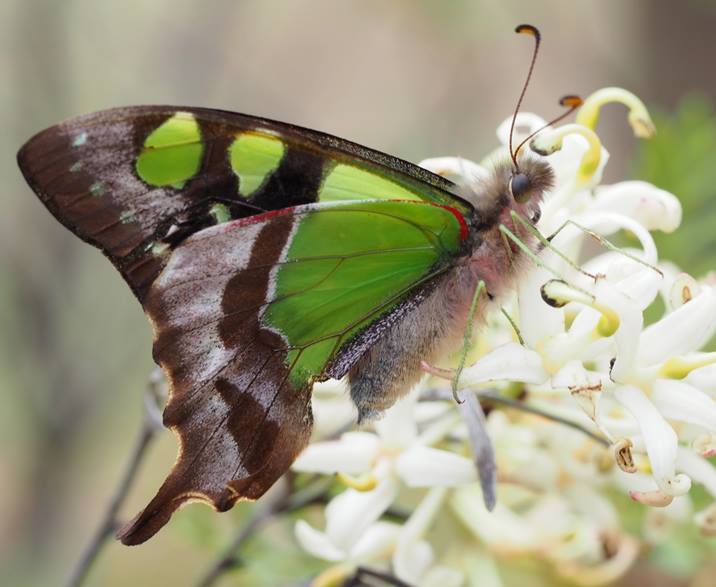
Summer Butterflies - Macleay's Swallowtail
Graphium macleayanus LEACH, 1814
Family - PAPILIONIDAE
Tribe - LEPTOCIRCINI
The genus Graphium is widespread in the Old World, with 35 species in the Afrotropical region, 14 in the Oriental region, 6 in the Holarctic ( south & west China ) and 20 in the Australian region. They are called 'swallowtail butterflies'.
Most of the Oriental and Australasian species are characterised by the presence of a pattern of translucent green, turquoise or yellowish "windows" in their wings.
Males commonly imbibe mineralised moisture from bare ground, especially in stony or rocky areas. Females seem to be much scarcer than males, and are usually only encountered when they nectar at the flowers of trees, bushes or herbaceous plants.
Sometimes on hot mornings large numbers of males, and much lower numbers of females, can be found "hill-topping", i.e. gathering at what is effectively a lek, on a hilltop or mountain ridge. This behaviour is common among the Papilionidae and other butterfly families. It enables low density forest-dwelling species which would otherwise have difficulty in locating mates, to home in on a meeting place.
The Photograph here, courtesy of the Tasmania Parks and Wildlife Service, was taken this week - just one of Australia's many summer butterflies!
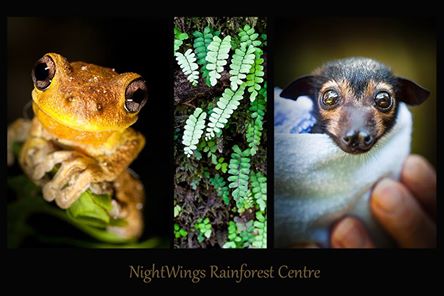
NightWings Rainforest Centre - Help Grow New Rainforest In Tropical Queensland
We need your help to create something very special. NightWings Rainforest Centre will encompass 15ha (37 acres) of brand new rainforest adjoining the World Heritage listed Daintree National Park.
We are three committed people determined to create a legacy. Land has been purchased, but we now need your assistance to help fund, to grow and plant 70,000 rainforest trees in six stages, starting December 2015 with the first 10,000 trees, to further increase wildlife habitat in the most bio-diverse region of Australia.
This is a very exciting and worthwhile project and we hope you can help. Just follow the link to donate. We all thank you in advance, Dave, Connie & Annie (the NightWings team)
Donate funds at: http://igg.me/at/hQILGm9AzmE/x/2115836
Streamlined approach to managing flying-foxes
Media release - 22 December 2014
Problematic flying-fox camps will be easier to manage with the release of draft camp management guidelines for the Grey-headed and Spectacled flying-fox.
These guidelines provide methods the community can use to disperse flying-fox colonies, where there are concerns for public health, in a way that does not impact upon the species.
Flying-foxes play an important ecological role as pollinators and dispersers of native plant seeds, but when they gather in large groups they can cause noise, smell and health concerns for nearby residents.
These guidelines describe options for low-cost and low-risk methods to disperse flying-fox populations, such as tree-trimming or boundary clearing. Communities will be able to undertake these activities without requiring approval from the Australian Government.
Importantly, the guidelines do not allow for lethal actions such as culling.
The Grey-headed flying-fox can be found widely across Queensland, NSW, ACT, Victoria and South Australia in search of food. The Spectacled flying-fox ranges across Far North Queensland. This means that national coordination is very important for managing the camps of these highly mobile species.
The policy has been developed through consultation with flying-fox experts and state and territory government agencies. It also draws on an improved understanding of flying-fox numbers and movements gained through the National Flying-fox Monitoring Programme.
The draft guidelines are open for public comment until 30 January 2015 and are availablewww.environment.gov.au/biodiversity/threatened/species/flying-fox-policy-statement
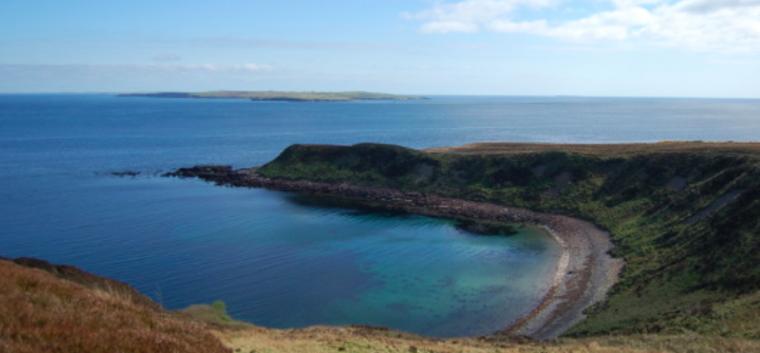
Worlds largest tidal energy project taking place in Scotland
By Holly Royce, 1MillionWomen Head of Social Media
Some really exciting news, the world’s largest tidal energy project is set to launch in northeast Scotland next month!
Marine Renewables or marine power refers to the energy carried by our oceans. The movement of the water creates kinetic energy which is then harnessed to power homes, etc. Ocean energy has the potential to provide a vast amount of new renewable energy around the world.
Think Progress reports:
“Capable of powering nearly 175,000 homes in the U.K. with 400 megawatts of power, the project will break ground next month in northeast Scotland. Atlantis, majority owner of the MeyGen project, announced that its flagship project had met all the conditions required to start drawing down finance through the U.K.’s Renewable Energy Investment Fund.
The completed project will have 269 sunken turbines, according to Atlantis, which expects to have about 60 of these installed and delivering power by 2020.
In the announcement to investors, Atlantis said: ‘The major construction and supply contractors to this iconic project have commenced design, engineering and procurement works in readiness for commencement of onshore construction at the project site in Caithness in January 2015.’
Tim Cornelius, Chief Executive Officer of Atlantis, said that Lockheed Martin’s project-specific 1.5 megawatt turbines were scheduled to be delivered on time for construction purposes. In November, the MeyGen project was awarded the first-ever Navigator Award at the International Conference on Ocean Energy, in recognition of the ‘project’s significant contribution to global marine renewable industry.’”
Great news, we can’t wait to see it in action!
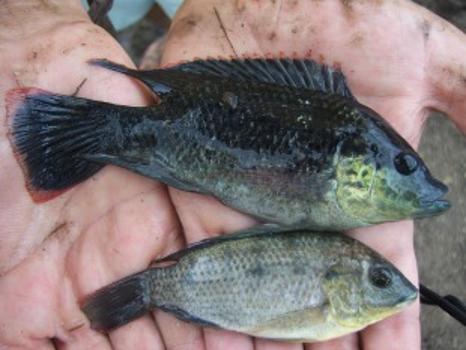
Help stop the spread of pest fish Tilapia
17 Dec 2014
The Department of Primary Industries (DPI) is seeking assistance from the public to help stop the spread of Tilapia, one of the world's most invasive fish species, after they were recently detected in the far north east of the State.
DPI Strategy Leader Aquatic Biosecurity Melissa Walker said community assistance is urgently needed to control the spread these pest fish, which were recently found in Bogangar Canal and Cudgen Lake, south of Kingscliff.
"The highest risk for transporting Tilapia is via humans carrying live fish or eggs," Ms Walker said.
"If people catch or find a Tilapia, it is vital that the fish is not returned to the water.
"Our advice to anyone who catches or finds Tilapia is to humanely destroy and dispose of it appropriately.
"In any case of uncertainty about identification, we recommend taking a good quality photo then calling the Aquatic Pest Hotline immediately for confirmation."
Ms Walker said Tilapia have pale olive to silver-grey bodies, with a long continuous dorsal fin, and can grow to more than 36 centimetres and live up to 13 years.
"The fish are particularly threatening because they are such successful breeders," Ms Walker said.
"Mothers produce up to 1200 eggs a year and protect their young fry in their mouths for up to 14 days before releasing them.
"This technique, known as 'mouth brooding', ensures that even if the mother is not living, any eggs in the mouth have the potential to survive.
"Once established in a flowing river or creek, these fish are almost impossible to eradicate so it is important to stop the spread of tilapia now before it's too late."
Tilapia impact on native fish numbers by competing for habitat and food, behaving aggressively, disturbing aquatic vegetation and could potentially introduce disease and parasites.
DPI Fisheries and Biosecurity staff are working with local council to coordinate surveys of the surrounding areas to help inform potential management options for this invasive pest fish.
Sightings of Tilapia can be reported to DPI by:
* Phone: 02 4916 3877 (24 hour hotline)
* Online or via
Top: Male and female Tilapea (photo Qld DAFF)
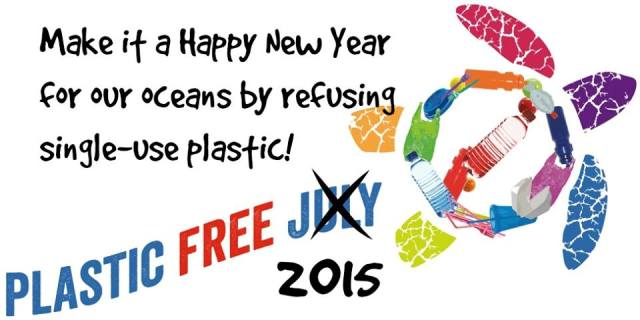
Proposed amendments to the Priorities Action Statement - NSW OEH
The Chief Executive of the Office of Environment and Heritage proposes to amend the NSW Threatened Species Priorities Action Statement (PAS) by replacing the current recovery and threat abatement strategies for 28 species with new draft recovery and threat abatement strategies.
The implementation of recovery and threat abatement strategies in the PAS is prioritised in accordance with the methodology explained under 'Prioritisation across management streams' on pages 8 and 10 of Introducing Saving our Species (Office of Environment and Heritage 2013).
Performance indicators have been established to facilitate reporting on achievements in implementing recovery and threat abatement strategies and their effectiveness in accordance with the monitoring, evaluation and reporting framework and as set out in the draft strategies.
You can submit comments on the amendments to the PAS:
By email: Send comments to pas.amendment@environment.nsw.gov.au
By mail: Post a written submission to Amendment to the Priorities Action Statement, Office of Environment and Heritage, PO Box A290, Sydney South NSW 1232.
Online: By completing the form on this webpage
The comment period closes on Friday 13 February 2015.Submissions will be made publicly available unless otherwise advised.
Lists and links at:www.environment.nsw.gov.au/threatenedspecies/ProposedPASAmendmentSpecies.htm
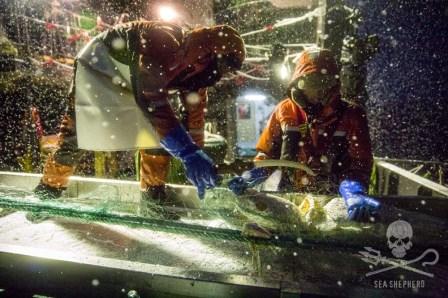
Sea Shepherd Commences Recovery of Second “Monster” Gillnet in Antarctica - inside CCAMLR Protected Area
Friday, 02 January 2015 - from Sea Shepherd
Within two hours of successfully recovering the 25 kilometre-long illegal gillnet abandoned by the Interpol-listed poaching vessel Thunder, the Sea Shepherd ship Sam Simon reported that it has located a second, “monster” gillnet.
The second illegal gillnet was found on the December 29, 2014 at 62˚ 20' South, 081˚ 18' East, just a few miles from the first net, inside the Commission for the Conservation of Antarctic Marine Living Resources (CCAMLR) area of management.
Using photographic evidence, Sea Shepherd has been able to confirm that the most recent gillnet is also the property of the Nigerian-flagged, Thunder, which fled from the region on December 17.
The crew of Sam Simon has commenced a recovery operation to remove the illegal gillnet from the Antarctic waters. Captain of the Sam Simon, Sid Chakravarty, said, “With more streamlined and efficient operations in round two, I am confident that we will recover the entire length of this net in just a few days. Thereafter I will move on to scout and clear the Banzare Bank of any other nets laid down by the Thunder.”
Based on the the first 24 hours of the retrieval operation, it is expected that the haul of the “monster” gillnet is twice that of the previously confiscated 25 kilometre-long gillnet.
Captain Chakravarty said, “This monster net has entangled and suffocated marine life, killing them in the most undignified way imaginable. My decks look like a battlefield with many of the recovered creatures in advanced stages of decomposition. The large number of dead animals that we have documented is proof of the wide-spread destruction that the Thunder has wreaked over its decade-long onslaught on the Southern Ocean. ”
Sea Shepherd has reported the second retrieval operation to the relevant law enforcement authorities, including Interpol, CCAMLR, the Australian Fisheries Management Authority and the Australian Federal Police. The confiscated equipment will serve as physical evidence of the Thunder’s illegal activity and will be handed-over to authorities to aid in prosecution of the Thunder.
A known poaching vessel, the Thunder was issued with an Interpol Purple Notice following a joint effort by Norwegian, New Zealand and Australian authorities, and is currently included on CCAMLR’s black-list of Illegal, Unreported and Unregulated (IUU) fishing operators.
The use of gillnets has been outlawed by CCAMLR since 2004, and the Commission has specifically expressed concerns regarding the impact of this fishing method on the marine ecosystems of Antarctica.
The Sea Shepherd ship, Bob Barker, has been in pursuit of theThunder for seventeen days and is now in the South Indian Ocean, having escorted the poachers out of the CCAMLR region on December 29. During this time the Thunder has been unable to engage in any further illegal fishing.
Top: A decaying toothfish, hauled from the “monster” net. Photo: Jeff Wirth
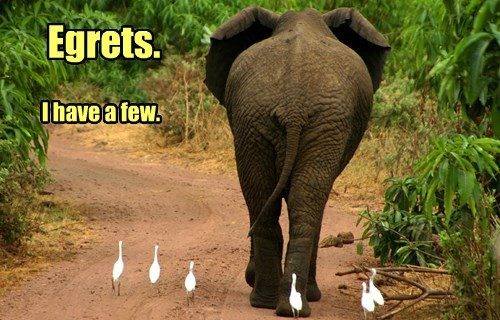
INDEPENDENT BIODIVERSITY REVIEW RELEASED
Troy Grant MP, Deputy Premier of NSW Rob Stokes MP, Minister for the Environment
MEDIA RELEASE - Thursday 18 December 2014
NSW Deputy Premier Troy Grant and Environment Minister Rob Stokes today welcomed the independent expert panel report on the review of native vegetation and threatened species laws.
Mr Grant said the independent panel’s recommendations included replacing the Native Vegetation Act, Threatened Species Act and parts of the National Parks and Wildlife Act with a new single piece of legislation that will ensure a balanced approach is taken in managing biodiversity, using a triple bottom line approach.
“The NSW Government is yet to form a response to the review but it’s pretty clear that based on this independent review, the Native Vegetation Act should be abolished,” Mr Grant said.
“I am confident the independent review’s findings will help us chart a path forward.
“For too long, farmers have been treated differently to all other landholders in the State and have faced many regulatory burdens in managing their land.
“Farmers are some of the best possible custodians of our land as they have a direct interest in ensuring biodiversity is sustained into the future.
“Government action on this has taken far too long, but we are firmly committed to fixing the mess left by Labor.”
Mr Stokes welcomed the panel’s recommendations and a proposal to draft a new, integrated Biodiversity Conservation Act.
“The proposals set out in the report will modernise and simplify a fragmented and aging set of biodiversity laws that have never been comprehensively reviewed,” Mr Stokes said.
“The proposals in this report offer a once-in-a-generation opportunity to implement transformational reforms and put in place a new law that will drive positive biodiversity conservation outcomes in NSW.
“I particularly acknowledge the recommendations that the Government must consider significant additional investment in private land conservation and our threatened species programs.
“The panel has made it clear that their recommendations should be implemented as an integrated package of reforms. This is necessary to ensure that we achieve our dual objectives to facilitate ecologically sustainable development and to conserve our environment.”The NSW Government will now consider the report and provide a response before the 2015 election.
To view the report, visit:www.environment.nsw.gov.au/biodiversitylegislation/review.htm
Independent review of biodiversity legislation in New South Wales
22 December 2014 - In June 2014, the Minister for the Environment appointed an independent panel to conduct a comprehensive review of the Native Vegetation Act 2003, Threatened Species Conservation Act 1995, Nature Conservation Trust Act 2001 and those parts of the National Parks and Wildlife Act 1974 that relate to native plants and animals and private land conservation.
Final report
The panel presented its final report to the Minister for the Environment on 18 December 2014. The panel has made 43 recommendations, proposing an integrated package of reforms to deliver on the NSW Government’s commitments to cut red tape, facilitate sustainable development and conserve biodiversity. The panel’s final report can be viewed in full here.
Terms of reference
Please click here to see the terms of reference for the review.
Consultation
To help inform its review, the panel met with a number of stakeholders, called for public submissions, commissioned input from NSW Farmers and the Environment Liaison Office, received advice from OEH and other government agencies and visited landholders and industry in the Central West, Upper Hunter, Walgett and Cooma-Monaro regions.
Public submissions
Public submissions to the review can be viewed here. A summary of the submissions report can be accessed here.
Background papers
A series of papers on specific issues related to the policy and legislative framework have been prepared by OEH:
Objects (PDF, 1.5MB)
Information provisions (PDF, 590KB)
Conservation action (PDF, 3.1MB)
Conservation in land-use planning (PDF, 316KB)
Conservation in development approval processes (PDF, 1.6MB)
Wildlife management (PDF, 212KB)
See all Background Papers HERE
Next steps
The panel’s report is now being considered by the government.
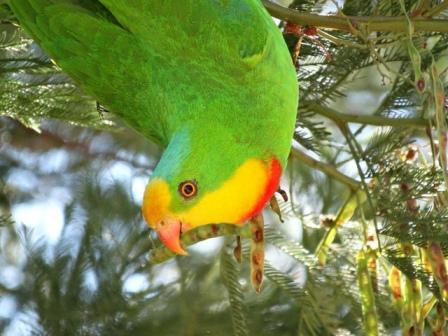
Watch out for Superb Parrots on the roads over Christmas
Media release: 18 December 2014
The NSW Office of Environment and Heritage (OEH) and local community members are concerned about recent reports of Superb Parrots being killed by vehicles on roads in the Boorowa and Young Shires. The birds were apparently feeding on spilled grain.
Grain spillage from trucks is one of the main threats facing the Superb Parrot, a threatened birds. About 15 years ago, a statewide campaign commenced to increase awareness of the issue. This included providing signage at grain silos and weighbridges throughout the NSW wheatbelt where Superb Parrots are known to occur.
This initiative was well supported by local grain growers and GrainCorp and most grain trucks now cover their loads, which has reduced roadkill of Superb Parrots and other birds that feed on spilled grain.
OEH Threatened Species Team Leader Damon Oliver said he had recently received two reports of dead Superb Parrots at Monteagle and Bendick Murrell. The reports came from members of a community-based Superb Parrot survey program.
Dr Oliver also recently saw a dead female Superb Parrot on a road near Murringo. The reports of dead Superb Parrots appear to be connected with grain trucks travelling along country roads in the Boorowa and Young areas.
“The birds land to feed and they fill up on grain. Birds are weighed down and have little chance of avoiding being hit by vehicles traveling at high speed,” Dr Oliver said.
“Unfortunately, Superb Parrots do not have the same road sense as Crows and other birds that often feed on roads and road verges.
“With a total population of only about 8000 birds, loss of birds from grain spill is a serious issue.”
Dr Oliver said many farmers in the NSW wheatbelt were aware of the Superb Parrot. He said some were protecting paddock trees and other vegetation the birds used for breeding habitat.
“It is very clear that the community cares for the Superb Parrot and is concerned to see birds getting hit on country roads.
“If you see a flock of Superb Parrots along a country road please slow down and consider sounding your horn when approaching.
“We are losing thousands upon thousands of native birds across the country to vehicles and if motorists safely slow down it will assist.”
Superb Parrot by Rosemary Stapleton
A Forest Year - from motionkicker
A Forest Year was made from 40,000 still images taken from my front window over 15 months, and were blended into the film.
Find out more about how it was made at motionkicker.com
Special thanks to Johnny_Ripper for letting me use his music.
soundcloud.com/johnny_ripper
a Forest Year from motionkicker on Vimeo.
Join the conversation about Commonwealth Marine Reserves
Written submissions to the independent review of Commonwealth Marine Reserves open today.
The co-Chairs of the Bioregional Advisory Panels, Professor Colin Buxton and Mr Peter Cochrane invite interested parties to provide them with ideas and suggestions on how marine reserves should be managed into the future.
“We are really keen to hear from a broad range of stakeholders and are hoping those with an interest will complete a simple online survey or provide a more detailed submission,” Professor Colin Buxton said.
The Review is focused on making sure that its work builds on the feedback and efforts that individuals and organisations have already made.
“We’re seeking new and additional information that address our terms of reference. The government has reproclaimed the outer boundaries of the Commonwealth Marine Reserve networks and the Coral Sea, so our focus is on their zonation and internal management.”
The Review has established five Bioregional Advisory Panels (representing the South-west, North-west, North, Temperate East and Coral Sea marine regions) to facilitate consultation with interested parties.
Details about making a submission can be found on the Join the Conversation page at www.marinereservesreview.gov.au. The online survey is expected to be available soon.
The submission period will remain open until 28 February 2015.
“We’d encourage everyone to get in early as this will help focus our efforts over the coming months,” Mr Peter Cochrane said.
“We’re looking for suggestions on how we can engage most effectively with affected parties and interests, to best explore options for zonation and management that will effectively and efficiently address concerns raised.”
The terms of reference can be found on the review websitewww.marinereservesreview.gov.au .
For background:
The terms of reference for the Review task the Bioregional Advisory Panels with providing government with:
•Advice on areas of contention with the Commonwealth marine reserves
•Advice on options for zoning boundaries to address those areas of contention
•Recommendations for improving the inclusion of social and economic considerations into decision-making for marine reserves, with particular regard to their management
•Suggestions for ongoing engagement of regional stakeholders
•Advice on information received through consultations that the Panels may feel influence, contribute to or improve the drafting of future management plans
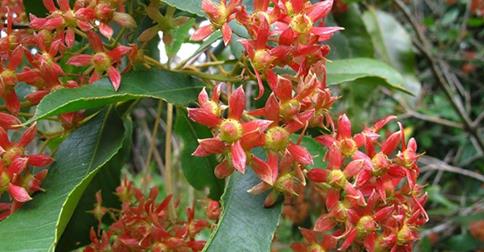
New Northern Beaches Plants Website
Pittwater native plants. PNHA member Gillian Gutridge is developing this website. Have a look! www.nbplantareas.com
Photo is Coachwood, cousin of NSW Christmas Bush, on Mullet Creek Warriewood.
A new agreement on environmental assessments for New South Wales
Joint media release - 15 December 2014: The Hon. Greg Hunt MP, Minister for the Environment, The Hon. Pru Goward MP, Minister for Planning
The Australian and New South Wales Governments has released for public comment an updated bilateral agreement on environmental assessments under national environment law.
The Australian Government is working with state and territory governments to streamline environmental regulation and develop a 'One-Stop Shop' for environmental assessment and approvals.
Federal Environment Minister Greg Hunt said that this new enhanced agreement will replace the assessment bilateral agreement currently in place and would deliver a more efficient process and greater certainty for business while maintaining the highest standards of environmental protection.
"This revised agreement builds upon the streamlining benefits of the current agreement, and introduces additional efficiency measures for environmental regulation in New South Wales.
"It is concrete evidence that our governments are progressively delivering on our shared objective to provide efficient, thorough and transparent environmental regulation in NSW while minimising duplication.
"Under this agreement, NSW will be accredited to conduct a project assessment under national laws and provide the Australian Government with a recommendation on whether to approve a project and what conditions should be attached to that decision under federal environment law," said Minister Hunt.
NSW Minister for Planning, Pru Goward, said that New South Wales will provide the Australian Government with rigorous and robust advice under national environment law.
"This will include jointly seeking expert advice from the Independent Expert Scientific Committee on Coal Seam Gas and Large Coal Mining Development for projects that are likely to have a significant impact on a water resource.
"Importantly, opportunities and timelines for the community to have a say about major developments are not proposed to change. This is about reducing needless hold-ups caused by two governments passing projects back and forth between them while they are being assessed.
"It means that projects in NSW will go through a single, NSW process, to ensure that high environmental standards are maintained."
A strong assurance framework ensures the best possible environmental protections remain in place including routine reporting, evaluation and review provisions, transparency and information sharing commitments and oversight of the agreement through a senior officers' committee.
Minister Goward said, “This new agreement reflects New South Wale’s determination to maximise the efficiency of the environmental assessment and approval process, and include a broader scope to ensure that more projects benefit from streamlined assessment.
"This agreement also recognises New South Wales' rigorous and transparent approach to determining offset requirements under its newly finalised NSW Biodiversity Offsets Policy for Major Projects."
The Australian Government remains committed to entering into approval bilateral agreements with all State and Territory Governments.
Approval bilateral agreements will ensure that only one decision is required for environmental approvals, accounting for both State matters and matters of national environmental significance.
This will further reduce the duplication of Federal and State planning processes which adds complexity, costs and delays to environmental approvals across the country.
Further information can be found atwww.environment.gov.au/topics/environment-protection/environment-assessments/bilateral-agreements
Deadline for comment: 5pm Monday 2 February 2015
2015 Prime Minister’s Literary Awards open
24 December 2014 - Prime Minister
Australian authors, poets and historians are invited to enter the 2015 Prime Minister’s Literary Awards.
The Prime Minister’s Literary Awards celebrate the contribution of Australian literature to our cultural and intellectual life.
These awards recognise the role Australian writers play in enlightening and entertaining us, reflecting on our history, and taking our stories to the world.
They acknowledge excellence in Australian fiction, poetry, non-fiction, young adult fiction and children’s fiction, and in Australian history.
A total prize pool of $600,000 is available to winners and shortlisted authors in these six categories.
The 2015 awards are now open for books first published in English and made available for general sale in Australia between 1 January 2014 and 31 December 2014.
Entries close at 5.00pm (AEDT) on Saturday 28 February 2015.
Entry forms and eligibility guidelines are available on the Ministry for the Arts website.
Malaria combination drug therapy for children
December 30, 2014 – A drug combination of artemisinin-naphthoquine should be considered for the treatment of children with uncomplicated malaria in settings where multiple parasite species cause malaria according to Tim Davis from University of Western Australia, Fremantle, Australia and colleagues in new research published in this week's PLOS Medicine.
Malaria is a mosquito-borne parasitic disease that kills approximately 600,000 people every year. Several different parasite species cause malaria and in some settings, such as Papua New Guinea, two species, Plasmodium falciparum and Plasmodium vivax, are responsible for the majority of malaria infections. However, the two species respond differently to currently available anti-malarial drugs.
The authors compared the current recommended therapy for uncomplicated malaria in children in Papua New Guinea, artemether-lumefantrine, with a different combination therapy, artemisinin-naphthoquine. Using a randomized, controlled trial study design including 186 children with Plasmodium falciparum infections and 47 children with Plasmodium vivax infections, the researchers found that artemisinin-naphthoquine was non-inferior to (no worse than) artemether-lumefantrine for treating Plasmodium falciparum (a difference of 2.2% [95% confidence interval ?3.0% to 8.4%] for reappearance of infection within 42 days) but was more effective for treating Plasmodium vivax (a difference 70.0% [95% confidence interval 40.9%-87.2%] for reappearance of infection within 42 days).
The authors conclude, "[t]he efficacy, tolerability, and safety of three daily doses of artemisinin-naphthoquine suggest that this regimen should be considered together with other currently available effective [artemisinin combination therapies] for treatment of uncomplicated malaria in [Papua New Guinea] and similar epidemiologic settings with transmission of multiple Plasmodium species."
1. Moses Laman, Brioni R. Moore, John M. Benjamin, Gumul Yadi, Cathy Bona, Jonathan Warrel, Johanna H. Kattenberg, Tamarah Koleala, Laurens Manning, Bernadine Kasian, Leanne J. Robinson, Naomi Sambale, Lina Lorry, Stephan Karl, Wendy A. Davis, Anna Rosanas-Urgell, Ivo Mueller, Peter M. Siba, Inoni Betuela, Timothy M. E. Davis. Artemisinin-Naphthoquine versus Artemether-Lumefantrine for Uncomplicated Malaria in Papua New Guinean Children: An Open-Label Randomized Trial. PLoS Medicine, 2014; 11 (12): e1001773 DOI: 10.1371/journal.pmed.1001773
A Long Shot that Paid Off: CSIRO's Atomic Absorption Project (1970)
Published on 31 Dec 2014
The discovery in the early nineteenth century that chemical elements could be identified by observing their emission spectra let to the development of accurate methods of chemical analysis based on atomic emission spectra. But it was nearly 100 years before Dr A. Walsh of the CSIRO Division of Chemical Physics started asking questions and became convinced that there would be many fundamental advantages in using spectrochemical methods based on atomic absorption spectra.
Despite many technical difficulties and lack of interest overseas, Dr Walsh and his colleagues persisted and finally showed that the technique they had devised had widespread applications in fields as diverse as medicine, engineering, agriculture and mineral exploration.